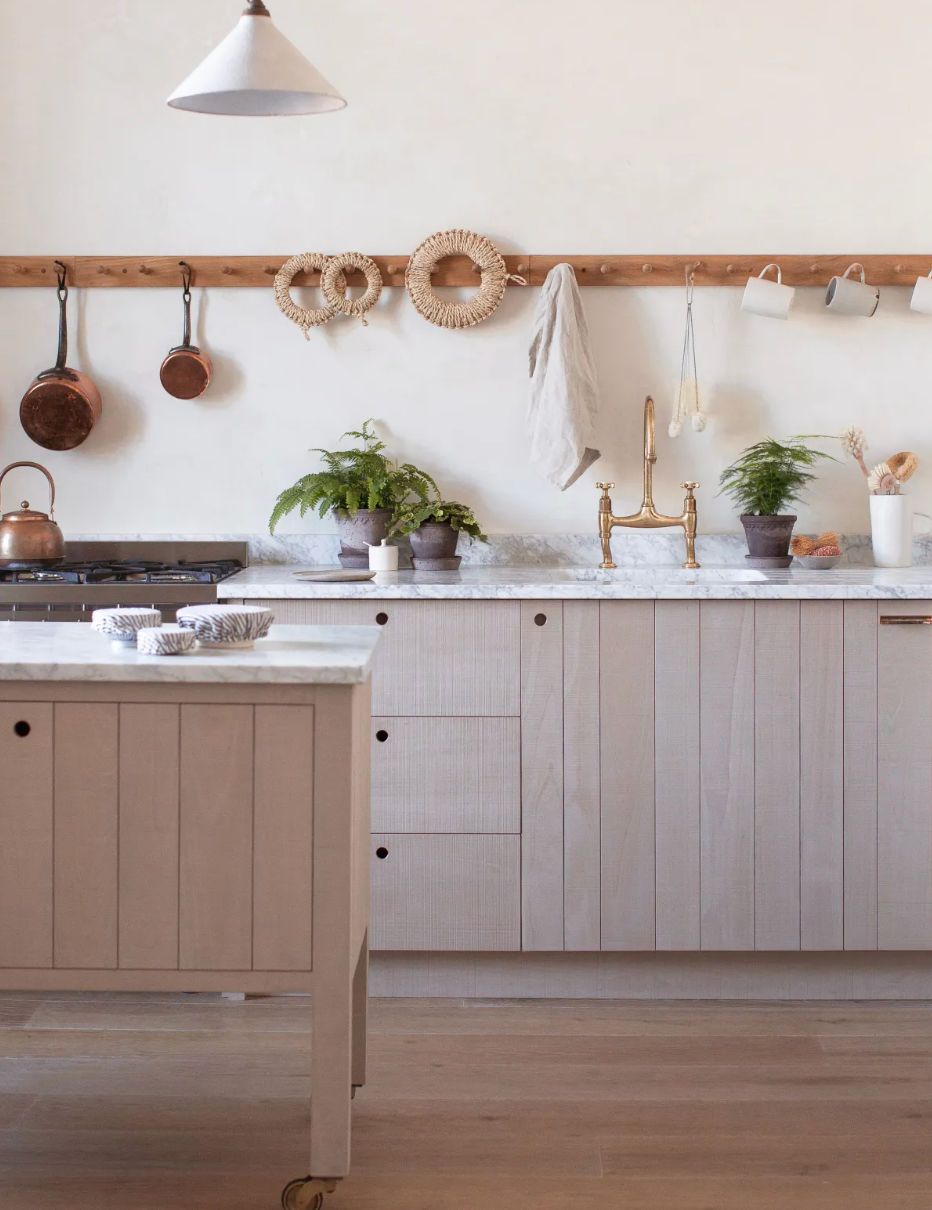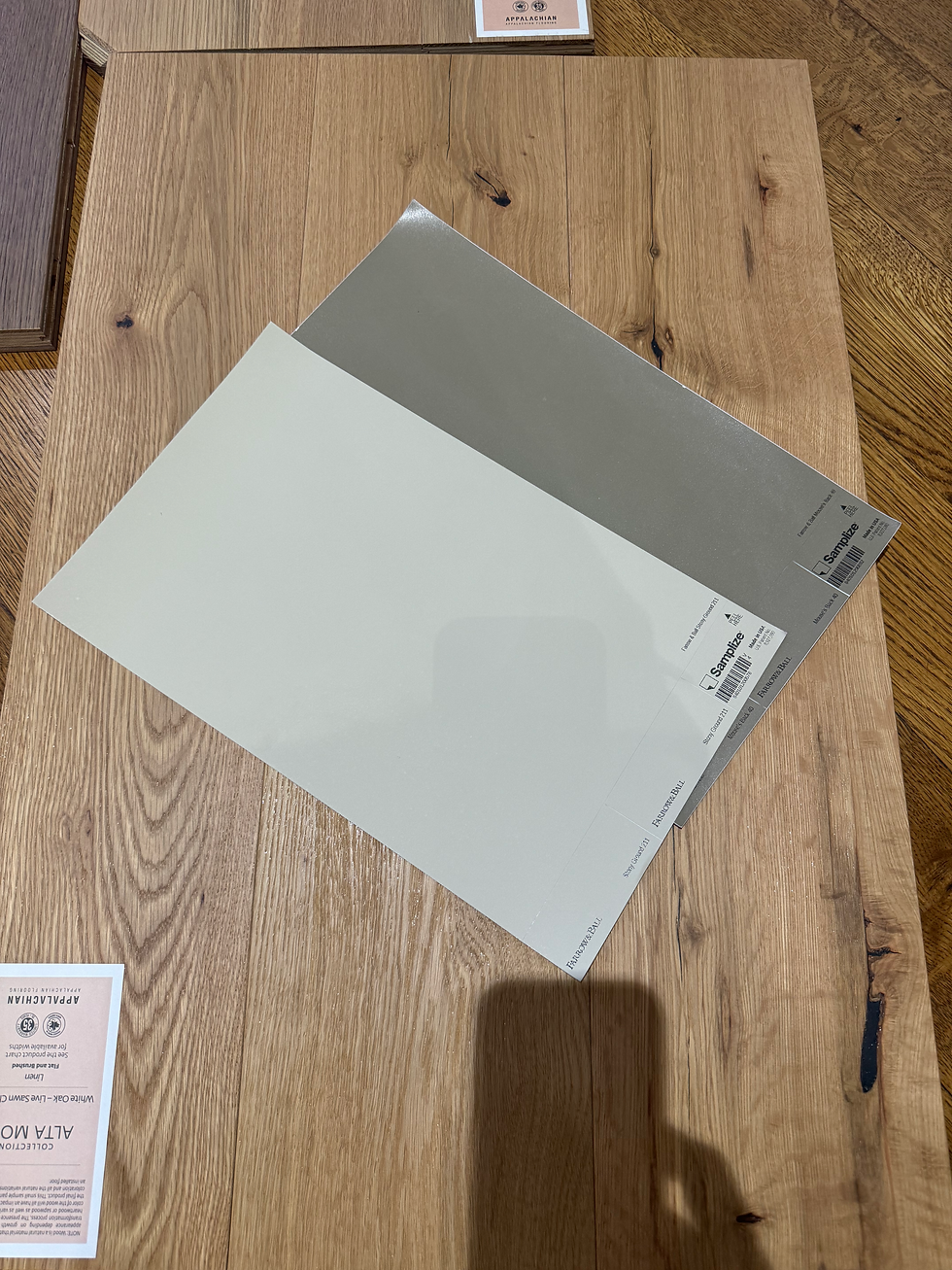Transforming a 1950's Cape Cod Latest Updates from our Remodel. From Drywall to Design: Laying down our wood floors and 4 reasons why we selected hardwood floors vs engineered wood flooring
- Carrie Lucke
- Aug 10
- 6 min read
The moment has finally arrived. After what felt like weeks of staring at white, dusty walls and navigating around ladders, we’ve officially moved past the drywall phase of our remodel. The joint compound is dry, the sanding is done, and the vacuums have never worked harder.
Now, it’s time for what I like to call the “pretty stuff”—the layers that actually make a house start to feel like a home. And first up? Floors.
We put down solid hardwood, white oak to be specific, in the main living spaces. The mud hall and two bathrooms are getting tile for practical reasons but aside from those small spaces the home will have the same white oak everywhere.
Why Flooring Feels Like a Big Milestone
Drywall marks the end of the structural work, but flooring is the start of the style work. This is the moment where the spaces will start to take on the personality and warmth I have had in my head for months. I can suddenly envision furniture placement, feel the comfort underfoot, and watch the tone of the space change instantly. Plus, once the floors are in, every other finish—from paint to cabinets—finally has context.
For our home, we wanted the durability and timeless look of real wood, but the decision wasn’t straightforward. That led us to a little deep dive into solid hardwood vs. engineered hardwood before we committed.
Solid Hardwood vs. Engineered Hardwood: What You Should Know

Solid Hardwood Floors
Construction: Planks milled from a single piece of wood, usually ¾-inch thick.
Lifespan: Can last generations (50–100 years or more) if cared for, since you can sand and refinish many times.
Look & Feel: The “real deal” in terms of authenticity, warmth, and sound.
Installation: Typically nailed down over a wood subfloor. Not recommended for below-grade spaces or areas prone to moisture.
Pros:
Long-term investment
Can change stain color in future
Timeless appeal
Cons:
More susceptible to expansion/shrinkage from humidity changes
Not ideal for bathrooms, laundry rooms, or basements
Engineered Hardwood Floors
Construction: A top layer of real hardwood bonded to multiple layers of plywood or fiberboard underneath.
Lifespan: 20–40 years, depending on the thickness of the top veneer and how many times it can be refinished.
Look & Feel: Still real wood on top—visually, it’s hard to tell apart from solid hardwood.
Installation: More versatile—can be nailed, glued, or floated. Suitable for basements and concrete slabs.
Pros:
More stable in varying humidity
Works well with radiant heating systems
Often slightly more budget-friendly
Cons:
Limited refinishing potential
Lower overall lifespan than solid wood
Our Choice: how we landed on solid hard wood instead of Engineered.
We opted for solid hardwood in the main living spaces for its long-term durability and the fact that we can refinish it down the road if we change our style. For the mud hall and bathrooms, we’re doing tile—because those areas see wet boots, dripping umbrellas, and splashes from morning routines.
The solid hardwood will bring that warm, classic look through the heart of our home, while the tile will hold up beautifully to water and grit without losing style points. We went with white oak vs. red. While white costs a little more, it takes a neutral stain more easily at all color levels, and that was important to me. I have pulled out my hair on projects with clients trying to explain to homeowners the limits of what their red oak floors can look like. Red oak generally looks nice with a clear coat (runs a little pink if you study it) but looks pretty. It also looks good in dark stains. Going dark on red oak helps eliminate the wonky tones. Anywhere in the middle, you can get yellow or orange-looking floors.
Additionally, we thought hard about using a wide plank rough sawn white oak in an engineered product. To say it made my heart go pitter-patter is an understatement. This is a very European look that mimics what the floors are like in the oldest properties in the UK and France. It mimics the type and cut of wood and offers a wide plank option that you simply can't get in 3 or 4" solid hardwoods. Due to humidity changes, wider planks can cup and buckle, but the stability of the engineered products helps to reduce this risk, allowing for the use of wider planks. Although I loved the wider plank look, I knew it would be irresponsible in a solid hardwood floor - if I was going wide... that would mean an engineered floor.
Over the past few years, I have been obsessing over Devol kitchens just for this look they are famous for. You see this beautiful hardwood in IG design files and design magazines - now you know where it originated from and why we all love it so much. And the only way to get it without spending an insane amount of money on reclaimed wood boards from Europe, is to find an engineered hardwood product that mimics this style.

Here is the sample of the engineered product I originally wanted to use in my home. You can see how it mimics the look of the wider plank, rough and knotty. It's a very casual look—and very on-trend at the moment. But trends come and go, and while these floors are classic, the trend is being used in the United States as a means to reference some of the oldest European homes. So why did we opt to get solid hardwood instead?

Why did we still opt for solid hardwoods? Let me tell you why -
Longevity
Simply put, we have lived in several old homes and have come to appreciate the longevity of solid hardwoods. We renovated 2 homes in which we were able to keep the flooring and simply sand and re-stain the floors to revive and bring them up to date. We wanted the same value in this home. Color trends change—in the early 2000s, every kitchen was white with dark oak floors. Now we are using color in our cabinets and walls, and light to mid tones work best. I want my floors to stand the test of time no matter what trends come and go. While at this moment my favorite look is the European wide plank, thinking long-term, solid white oak felt like an insurance policy.
Flexibility
Quite simply, white oak takes stain more neutrally than other woods. It gives me the option to go lighter on the second floor and mid-tone on the first floor without having different flooring. When we bought this home, it had different flooring in every room of the house. It was important to me that when we finished, aside from rooms that practically needed tile, I would have the same flooring material throughout the home.
Color Control
In addition to preferring the way white oak takes stain at all color levels, I also felt very vulnerable with the prospect of buying 4,000 sq feet of an engineered product and perhaps not liking the way it looked when I saw it over a larger space. Case in point -
When I was evaluating the engineered product, I had more or less at one point decided that it was what I wanted. I fell in love with the sample board pictured above. Loved the way it looked with my main paint color choices. All the things. I went to the flooring company and requested a smaller sample that I could hold onto during the design process. They presented me with a sample board and... it looked green to me! I did not like that piece. It looked totally different - and not in a good way. I realized at that moment that when I order all this flooring and it gets shipped from Canada, there is no going back, no re-staining, no control or flexibility. I knew at that moment that this was not the product for me for this project.
Future Proofing for Next Phase of Remodeling
Finally, we have a primary suite area we are holding off on remodeling until a later date. We wanted to be able to match the flooring in this space with the rest of the house. This was paramount to the decision. The engineered product could change or be discontinued. I did not want to take this risk.
Below is the white Oak 3.5" solid hardwood we installed - before any staining is applied
What’s Next
Now that we have our wood floors installed, over the next weeks we will finish up on tile work and looking forward to cabinet deliveries and eventually paint. Stay tuned for all these things to come.
After months of working on the bones of the house, it’s incredibly satisfying to finally start adding the design layers that make it ours.











24 years ago we went with engineered, hardwood floor for a number of reasons and we don't regret it for a minute. Cost was v important to us, we were not in a position where total cost was not a v important consideration, like $2.50 (24 yrs ago) per sq. ft. verses over $8.00, plus expensive install vs. DIY. The finish from the factory was baked on and 24 years later it is still as shiny and tough. Yes, there are some small dents, nothing that doesn't look like "character," often admired in older wood floors. I am sure we could sand and refinish the 1\8 in. oak layer, but there really is no need since we like the floor's…